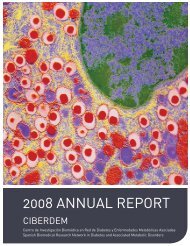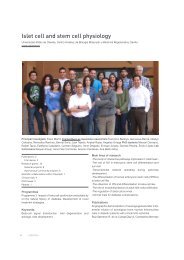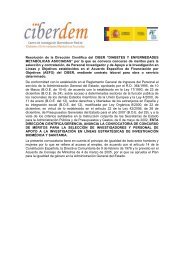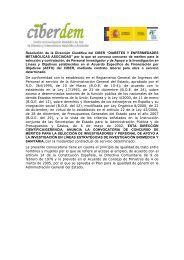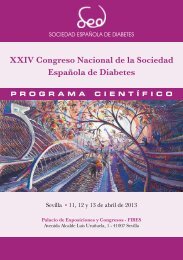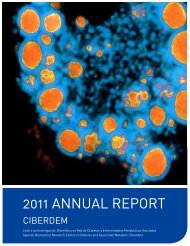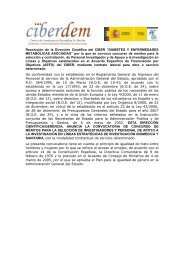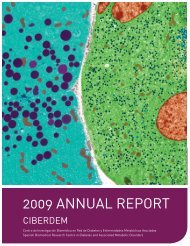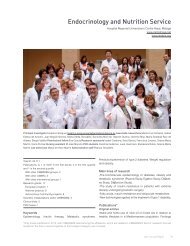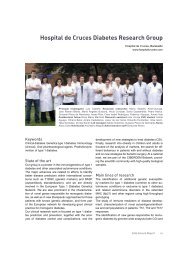2010 AnnuAl REpoRT - Ciberdem
2010 AnnuAl REpoRT - Ciberdem
2010 AnnuAl REpoRT - Ciberdem
Create successful ePaper yourself
Turn your PDF publications into a flip-book with our unique Google optimized e-Paper software.
CIBERDEM Projects<br />
Introduction<br />
CIBERDEM seeks to achieve scientific excellence in<br />
research and encourage bench-to-bed as well as bed-tobench<br />
transition (see figures 1 and 2). In order to achieve<br />
these goals it promotes collaboration between basic and<br />
clinical research groups to prioritize translational research<br />
in the network. To this end, 14 initiatives based mainly on<br />
diabetes and its complications planned to last a year and<br />
a half have been instituted. CIBERDEM forges synergies<br />
between its members and launches initiatives that can offer<br />
an attractive opportunity to build up collaborations with<br />
other centres outside the consortium, whether national or<br />
international, because these projects can be seen as a<br />
pool of scientific knowledge that involves several Spanish<br />
research groups of excellence in diabetes at the same time.<br />
Objectives<br />
To develop scientific actions focused on diabetes and its<br />
metabolic disorders with a high impact on research.<br />
To improve collaborations among CIBERDEM researchers,<br />
mainly among clinical and basic research groups (with a<br />
minimum participation of 3 research groups at any one time).<br />
To forge alliances between CIBERDEM researchers through<br />
joint work on the design and implementation of the projects.<br />
To demonstrate the competitiveness of CIBERDEM researchers<br />
and the innovation of their collaborative projects.<br />
To establish initiatives that a single CIBERDEM research<br />
group can not embark upon alone.<br />
Achievements in <strong>2010</strong><br />
14 CIBERDEM initiatives were implemented during 2009-<br />
<strong>2010</strong>. The Scientific Director and the Management Office<br />
followed these projects scientifically and managerially<br />
right from the outset and the researchers involved in<br />
the translational research actions worked hard in order<br />
to achieve successful scientific outputs which were<br />
disseminated both within and outside CIBERDEM.<br />
At the CIBERDEM Annual Meeting in <strong>2010</strong>, nearly 25% of the<br />
total oral presentations made focused on the explanation of both<br />
the work performed and the results obtained in the 14 actions.<br />
CIBERDEM Projects were also made known to the<br />
wider national and international scientific community.<br />
In this regard, oral presentations were made at several<br />
congresses worldwide. Moreover, many original articles<br />
were published in international peer review journals such<br />
as Endocrinology, PNAS, Diabetology and The Journal of<br />
Clinical Endocrinology and Metabolism (JCEM).<br />
The merits resulting from the 14 CIBERDEM Projects are<br />
included in this <strong>2010</strong> Annual Report and can be seen in the<br />
research outcomes of each research group participating<br />
in the initiatives.<br />
Future challenges<br />
In 2011 CIBERDEM aims to continue exploiting the results<br />
already obtained with the objective of demonstrating the<br />
impact of the investment that the consortium has made<br />
in the collaborative translational activity of their research<br />
groups. During the coming year, the Scientific Director and<br />
the Managing Director will work together to obtain additional<br />
Clinical research groups Basic research groups<br />
funding to continue with these initiatives, hopefully at the<br />
STEMOB<br />
3 5<br />
same level, MODIABor at<br />
1<br />
least to a<br />
3<br />
similar extent. The expected<br />
desirable LOWHDL aim is to 2be able to sustain 3 the contribution of<br />
IODURE 1 4<br />
these INGENFRED actions to the scientific<br />
3<br />
prestige<br />
1<br />
of the institution. It is<br />
important ENDODIAB not to forget 2 that 1the 14 CIBERDEM translational<br />
DOTUM 1 2<br />
research<br />
DIASOBS<br />
projects have increased<br />
4<br />
the<br />
1competitiveness of<br />
the CHILDBODYFAT activity of the centre, 2 providing 1 CIBERDEM with more<br />
opportunities for obtaining funding in the near future,<br />
from both the public and private sectors, always with the<br />
objective of assigning it to CIBERDEM diabetes research.<br />
NEURONET-DIAB<br />
METADIAB<br />
IREVAS<br />
GIDIPRED<br />
ANTIBETACELL<br />
Basic research groups<br />
Clinical research groups<br />
2 1<br />
1 2<br />
2 1<br />
1 2<br />
2 1<br />
Figure 1. CIBERDEM bench to bed projects (NEURONET-DIAB,<br />
METADIAB, IREVAS, GIDIPRED, ANTIBECELL) showing the number<br />
of research groups participating in each project (in green the<br />
groups with a basic profile, in red those with a clinical profile).<br />
STEMOB<br />
MODIAB<br />
LOWHDL<br />
IODURE<br />
INGENFRED<br />
ENDODIAB<br />
DOTUM<br />
DIASOBS<br />
CHILDBODYFAT<br />
Clinical research groups<br />
3 5<br />
1 3<br />
2 3<br />
1 4<br />
3 1<br />
2 1<br />
1 2<br />
4 1<br />
2 1<br />
Basic research groups<br />
Figure 2. CIBERDEM bed to bench projects (STEMOB, MODIAB,<br />
LOWHDL, IODURE, INGENFRED, ENDODIAB, DOTUM, DIASOBS,<br />
CHILDBODYFAT) showing the number of research groups participating<br />
in each project (in red the groups with a clinical profile, in<br />
green those with a basic profile).<br />
Basic research groups Clinical research groups<br />
NEURONET-DIAB<br />
METADIAB<br />
IREVAS<br />
GIDIPRED<br />
ANTIBETACELL<br />
2 1<br />
1 2<br />
2 1<br />
1 2<br />
2 1<br />
<strong>2010</strong> Annual Report<br />
23



